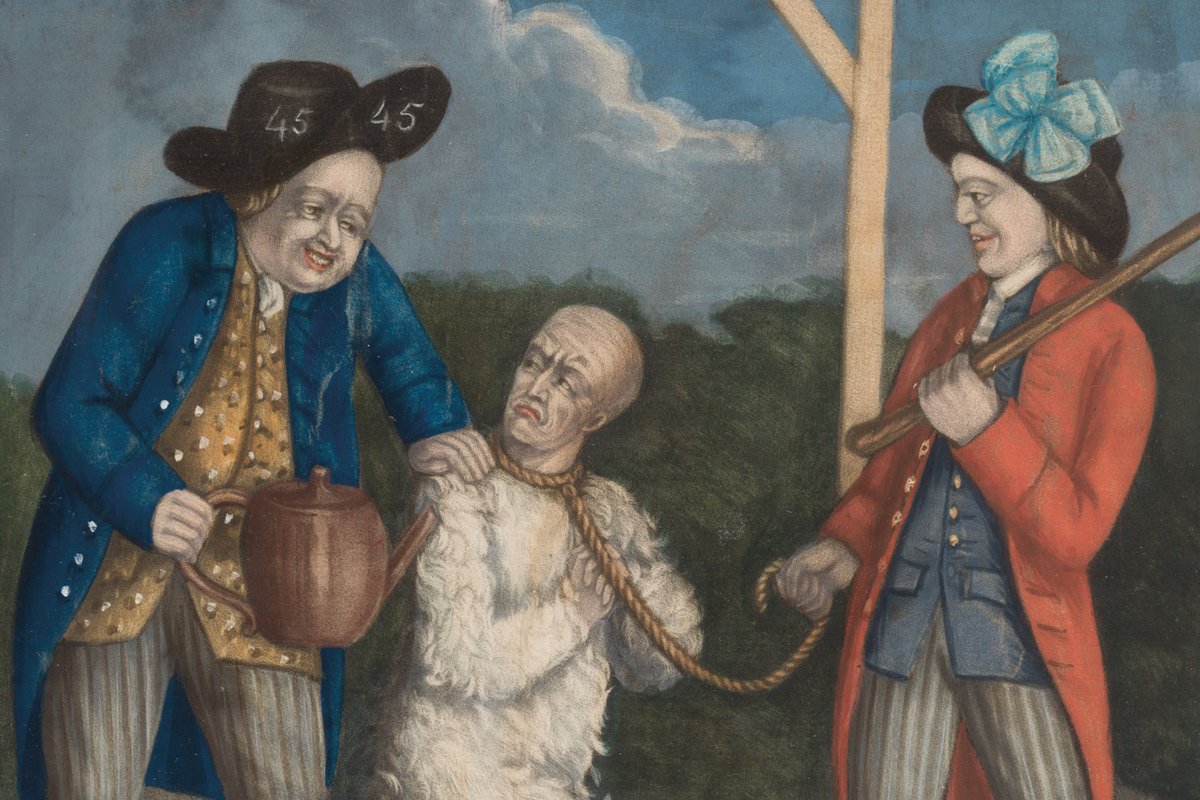
Loyal to the Crown
The Political Death and Rebirth of the Loyalists
In August 1775, a “merciless rabble” in Isle of Wight County, Virginia, captured the loyalist Anthony Warwick and “dragged him, frequently by the hair of his Head, the distance of ten miles” to Smithfield to face Revolutionary justice.
Warwick, a self-described man of “considerable property,” had defied the local committee and refused to turn over his shipment of tea and, more importantly, “a quantity of Gunpowder which he...destroyed...rather than suffer it to fall into their hands for the traitorous purpose...they designed it.” The crowd may also have learned that the Virginia merchant had sent supplies to British troops besieged in Boston.
After the war, Warwick testified to British commissioners that in Smithfield he had been “stript, even of his Shirt, tied to a public whipping post, and subjected to the shameful punishment of Tar and Feathers, in the presence of many hundred spectators.”
The Virginia Gazette applauded Warwick’s “fashionable suit of tar and feathers, being the most proper badge of distinction for men of his complexion.” Throughout Revolutionary America, the press amplified and broadcast loyalist disgrace.
Reasons to Remain Loyal
Warwick fits the stereotype of the aristo-cratic Tory, but loyalists came from all walks of life. Perhaps a fifth of American colonists were attached in some way to the British cause, and they defy easy categorization. Some were loyal for ideological reasons, others out of practical business interests. Many judges, lawyers and officials regarded the issue as a point of honor and would not break their oaths to the Crown. Others rejected the violence of the rebellion or could not fathom a world in which they were not part of the British Empire. And some simply found themselves behind British lines and had to make the best of things.
Whatever the reasoning, the Revolutionary War grafted onto existing local feuds and tore communities apart. Some family networks and associations hedged their bets and played both sides or attempted to stay neutral. Both Britain and the Continental Congress courted Indigenous peoples who were drawn into the conflict in hopes of retaining their lands and freedom against incessant encroachment.
Especially in the South, tens of thousands of enslaved Black people fled their captivity in search of the freedom offered in proclamations first by Virginia’s royal governor Lord Dunmore and later by British Gen. Henry Clinton. Names such as Anthony Loyal and Peter Brittain found in the “Book of Negroes” kept by British officers in New York testify to Black loyalists’ hopes for a new and better life.
The Perils of Picking the “Wrong” Side
Although loyalists represented a cross-section of colonial American society, myth and history preserved the memory of the effete, villainous gentleman Tory. And in reality, for white men who thought of themselves as gentlemen, the intense public humiliation Warwick experienced was a kind of death. He was stripped not only of his clothes but also his dignity, power and identity as a propertied man of public importance.
Warwick was a slaveholder tied to a whipping post, blackened with tar; a man who once wore imported suits, shamed in a coat of feathers; a merchant who held the county in his debt, who would never see a penny of what he was owed. And there was nothing he could do about it. The insults transformed a once powerful and privileged gentleman into a dishonored Tory.
The vast majority of loyalists were never tarred and feathered, but they were still denied what the Virginia loyalist the Rev. John Agnew referred to as the “rights of society.” Agnew testified that, to demonstrate his power-lessness, the rebels pilfered his farm, tormented his enslaved laborers, insulted his wife and locked him in a cell “with Sick and distempered Negroes and Sailors.”
Eventually, every state enacted some form of law to confiscate loyalist property. Ostracized, stripped of their rights, dishonored and emasculated, the loyalists were politically dead. The revolutionaries felt fully justified in attacking or banishing the internal enemies of their movement. One leading New York revolutionary wrote that the states “may rightfully banish...those, who aim at its subversion, and forfeit the property, which they can only be entitled to by the laws, and under the protection of the society, which they attempt to destroy.”
George Washington referred to loyalists as “parri-cides.” Throughout the war, the Revolutionary press consistently portrayed them as cowardly, treacherous villains who cared only for money and power. In the words of the South Carolina revolutionary David Ramsay, loyalists “unnaturally co-operated with strangers in fixing the chains of foreign domination on themselves and countrymen.” To forge the loathsome Tory archetype, patriot writers combined lurid tales of loyalist wives sleeping with British generals with reports of Tory cruelty on and off the battlefield.
The most despised loyalists were those who fought alongside Indigenous nations. Newspaper reports suggested that frontier Tories underwent a kind of metamorphosis and became indistinguishable from their Indigenous allies. At the bloody Battle of Wyoming, in eastern Pennsylvania, 300 patriot militia were killed. The Connecticut Courant reported, erroneously, that the militia were attacked by 1,600 men “about 300 of whom were...Indians...the rest, Tories painted like them.” The article called for “speedy and effectual measures...to punish and extirpate these monsters in human shape.”
A Complex Legacy
There were indeed atrocities committed by all sides in the Revolutionary War, but infamy stuck to the loyalists. A late-19th-century novelist described the “beast-like bloodthirstiness [of]...native-born Tories.” According to the narrator, “Beside them the lowest painted heathen in their train was a Christian, the most ignorant Hessian peasant was a nobleman.” Stephen Vincent Benét even included two frontier loyalists attached to the British Indian Department, Simon Girty and Walter Butler, among the jury of the damned in his short story “The Devil and Daniel Webster.”
Loyalists bristled at such accusations and believed firmly that they were the tragic victims in this drama. Though certain of their cause, they struggled throughout the conflict to broadcast their message and get organized. They never found their Tom Paine to articulate their cause, nor their George Washington to lead them. They had their heroes, like the swashbuckling James Moody, and some effective fighting units, like the Queen’s Rangers, but it was not enough.
Philadelphian Joseph Galloway lamented after the war that loyalists “look[ed] up to Government to take the lead in suppressing” the rebellion only to find their hopes dashed by incompetent generals who spent more time throwing parties in New York than fighting the war. Loyalists also felt betrayed and abandoned by the peace treaty of 1783, which did nothing to restore their lost lands and property. One Georgia exile summed up the loyalist sentiment: “It was not I [who] deserted my King, but my King that deserted me.”
Life After the War
If a fifth of the population were in some way connected to the loyalists during the war, most abandoned the cause afterward and simply went about their business as citizens of the new republic. Historians have noted the remarkably forgiving process of reconciliation, once tempers cooled, and even loyalists who bore arms for the British slipped back into everyday life in the late 1780s and 1790s. For some, a political rebirth among friends and families as American citizens was an honorable path to redemption.
For diehard loyalists, like the Harvard-educated New Englander Edward Winslow, such reconciliation was far more humiliating than exile. He denounced loyalists who gave up the cause as “giddy, eccentric, and discontented characters” who “made a voluntary sacrifice of their former honorable principles” and “meanly skulked into the United States.”
The hard-fighting men of Butler’s Rangers who settled near Niagara Falls agreed, writing that they “would rather go to Japan than go among the Americans, where they could never live in peace.” For them, political rebirth would be found in Canada.
Fleeing North
Perhaps 60,000 American refugees fled the United States in the aftermath of the war. Among them was Anthony Warwick. He briefly returned to North America in hopes of recovering his property and spent the final years of the war in British-occupied Charleston. He tried his luck in the West Indies before finally returning to England in ill health and “in worse circumstances” than when he first left. Eventually he rebuilt his trading business, but others were less fortunate. A fellow merchant loyalist, Alexander Telfair, despaired at his losses and continuing hardship and took his own life in 1786.
More than 40,000 settled in what became Canada. The majority took up lands in Nova Scotia and in New Brunswick, which the British established in 1784 as a loyalist refuge. Others went to Prince Edward Island, and some went further west to Quebec, which was divided in 1791 into Upper Canada, with its loyalist settlers, and Lower Canada, with its French-Canadian majority.
The British government and the loyalists set about the monumental task of settling thousands of people at once while also building counter-revolutionary societies. The elite loyalists who established New Brunswick’s government dreamed of building a society that would be the “envy of the American States.” Upper Canada’s first lieutenant governor, John Graves Simcoe, a British veteran of the Revolutionary War, sought to prevent any further rebellions by building “a perfect image and transcript of the British Government and Constitution.”
The loyalists did their best to rebuild the world they had lost, but restoring status and pride was a multigenerational task. A Canadian historian referred to loyalist sons and daughters as “redeemer children” who worked to achieve their parents’ dream.
The great test of that dream came with the American invasions in the War of 1812. Upper Canada by this point was still sparsely settled, and perhaps 20% of the population were loyalists. The rest were mostly settlers from the United States, attracted by land that could be had for a loyalty oath to the king. British authorities were doubtful that these “late loyalists” could be trusted. The situation looked grim.
The loyalists’ redeemer children, raised on tales of the Revolution’s injustice, played an important role in the conflict, stiffening the backbone of Upper Canadians and rooting out traitors.
Among those Canadian defenders was John Beverley Robinson, the son of the Virginia loyalist Christopher Robinson. Settled at York (now Toronto), the Robinsons established a prominent dynasty in the province. Acting as Upper Canada’s attorney general, John Beverley Robinson prosecuted Canadians who supported or joined the American invaders. At an infamous series of trials in 1814 that became known in Canadian history as the “Bloody Assize,” Robinson secured the death sentence for 15 men accused of treason, eight of whom were executed and the rest banished.
The survival of Upper Canada was a great vindication for the loyalists, but it was also a terrible warning for them to stay on guard against what they saw as the corrosive effects of republicanism. In the following years, loyalty to the British Crown became central to Upper Canada’s political culture, and one historian has noted the “Vesuvian mentality” of the loyalists who would explode at perceived threats from political reformers.
Canada’s Lasting Loyalist Impact
As the decades passed, the loyalist identity dissipated, though elements persisted into English Canadian culture. For much of the late 19th and early 20th century, public educators and nation builders embraced a loyalist myth of the genteel founders of English Canada. That myth has largely been replaced by a refugee narrative that more accurately includes Black loyalists and Indigenous allies.
Canadians and Americans today might not be aware of the significance of the political death and rebirth of the loyalists, but the reverberations continue to this day. The visit by King Charles III in May 2025 to open Canada’s Parliament, a gesture intended to assert Canada’s sovereignty, would make sense to the loyalists. It also serves as a reminder of the lasting impact of the political choices made by American colonists 250 years ago.
More from this Issue

